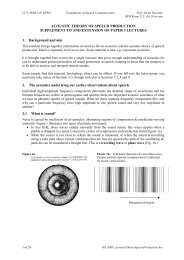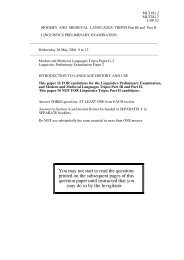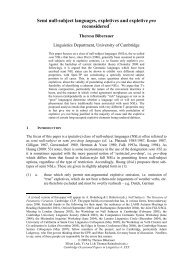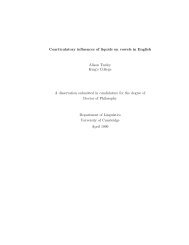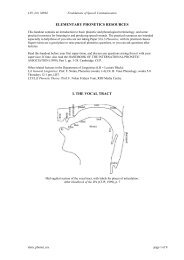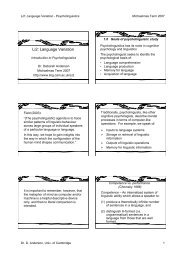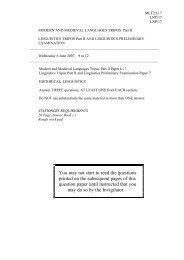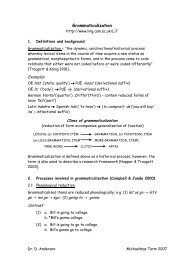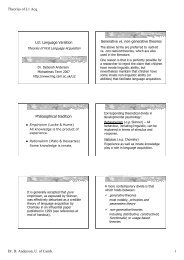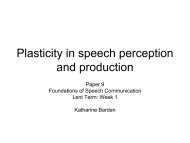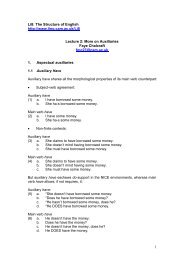ACOUSTIC THEORY OF SPEECH PRODUCTION ... - Ling.cam.ac.uk
ACOUSTIC THEORY OF SPEECH PRODUCTION ... - Ling.cam.ac.uk
ACOUSTIC THEORY OF SPEECH PRODUCTION ... - Ling.cam.ac.uk
Create successful ePaper yourself
Turn your PDF publications into a flip-book with our unique Google optimized e-Paper software.
Paper 9 etc: M4_AcThSpProd 7 of 20<br />
5.2 Simple tubes of uniform cross-sectional area<br />
The tube shape with the most general application to speech is a straight tube of uniform crosssectional<br />
area—i.e. no constrictions. The vocal-tr<strong>ac</strong>t shape for schwa ([´]) can be modelled as a single<br />
such unconstricted tube:<br />
closed end: glottis<br />
open end: lips<br />
Vocal tr<strong>ac</strong>t (VT) shapes for all other sounds must be modelled by more than one tube, because they<br />
involve at least one constriction, but the principles are essentially the same.<br />
6. What causes resonance in a straight-sided tube?<br />
For ideal tubes of uniform cross-sectional area, resonance arises when<br />
standing waves of pressure (and velocity) occur.<br />
A small volume of air in a tube can have a velocity (hence kinetic energy); it can also be compressed<br />
and expanded so that there are variations in sound pressure (hence in potential energy). A wave of<br />
sound pressure or velocity travelling down a tube is called a travelling, or plane wave. In an ordinary<br />
travelling wave of any given frequency, velocity and pressure (kinetic and potential energy) fluctuate<br />
together, either 0° or 180° out of phase.<br />
When a sound wave travels down a tube, it is reflected b<strong>ac</strong>k upon re<strong>ac</strong>hing the end of the tube. Cf.<br />
slinky spring.<br />
Reflections occur because the ends of tubes form <strong>ac</strong>oustic boundaries. (There are <strong>ac</strong>oustic boundaries<br />
even when a tube’s ends are open enough to allow air to flow out, as the lips are in the production of a<br />
vowel. Compare the way it can be hard to hear someone who’s talking inside a car with the window<br />
open, when you are outside the car.)<br />
All travelling waves in a tube are reflected from the ends. The amplitude of the incident (→) and<br />
reflected (←) waves sum to give the overall pattern of pressure and velocity fluctuation.<br />
Reflections of waves at most frequencies tend to create complex but variable patterns that do not<br />
excite resonances. But at certain frequencies, the pattern of incident and reflected waves sums to a<br />
simple pattern whose peak amplitude at any given pl<strong>ac</strong>e in the tube is maintained (“stands still”) over<br />
time. Hence the term standing waves.<br />
Standing waves thus arise when incident (→) and reflected (←) waves sum in such a way that:<br />
• their combined peak amplitude is constant over time at any one point in the tube, but<br />
• there are differences in peak amplitude at different pl<strong>ac</strong>es in the tube.<br />
There are only certain frequencies at which this can happen in any given tube (of uniform crosssectional<br />
area). In order for it to happen, the the wavelength of the sound must be the right length to<br />
fulfil certain boundary conditions.<br />
M4_0708_AcousticTheorySpeechProduction_07-8.doc



